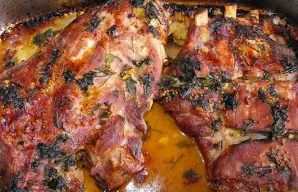Posted on Sunday, November 22, 2015 in
Pork Recipes
This is an amazing, and popular cozido à Portuguesa (boiled meal) recipe, it's traditionally served on Sundays in Portugal.
| Preparation time | 20 min |
| Cooking Time | 1 h |
| Ready In | 1 h 20 min |
| Level of Difficulty | Easy |
| Servings | 4 |
Nutrition Facts (Per Serving)
| Calories | 1226 |
| Fat | 69g |
| Carbs | 91g |
| Protein | 63g |
Ingredients
1/2 lb of beef chuck1/2 lb of pork spare ribs1/2 lb of pig’s forefoot1/2 lb of pig ear(s)1/2 chicken1/2 lb of bacon (toucinho)1 chouriço sausage1 black pudding (morcela)1 flour (farinheira) sausage6 medium sized potatoes3 turnips1 Portuguese cabbage3 carrotsSalt (to taste)2 cups of cooked rice (optional)
Get Portuguese ingredients 
Preparation
- Boil the beef and chicken in a large saucepan with plenty of water seasoned with salt.
- In another saucepan boil the pork meats, seasoned also with salt.
- Once the meats are cooked, keep them in a hot place and use half of the water used to boil the beef to cook the vegetables and the sausages, placing first the sausages, the potatoes, the turnips and the carrots and add the cabbage just before they are ready so that the cabbage does not overcook (Don’t forget to prick the sausages before placing them in the saucepan).
- Cut the meats in pieces and slice the sausages.
- Enjoy this meal with rice (optional, and a good and full bodied red wine, preferably Portuguese.
Recommended Recipes
Flavorful Portuguese Roasted Pork Ribs Recipe
This flavorful Portuguese roasted pork ribs recipe (receita de costeletas de porco assadas), does take a little time but it will be worth your time.
| Level of Difficulty | Moderate |
| Servings | 2 |
Amazing Portuguese Garlic Roasted Ribs Recipe
These amazing Portuguese garlic roasted ribs (costeletas assadas com alho), go great with mashed potatoes.
| Level of Difficulty | Very Easy |
| Servings | 2 |
Paula's Delicious Portuguese Chouriço à Bras Recipe
Paula's delicious Portuguese chouriço à bras recipe, is her own twist to the popular bacalhau à bras.
| Level of Difficulty | Easy |
| Servings | 4 |
Comments

Julie
I love cozido. I do make a difference I don't have the pig feet or the pig ears I don't like turnips or cabbage some mine is simple just potatoes and meat and the greens and I forgot the vegetables.
2 Years ago, Wednesday, November 8, 2023


Paul Santos
I also make a simpler version, without pigs ears and feet, Marcela and farinheira.
I do love it with everything, but because of kids, grandchildren and a non-Portuguese wife, I have to keep everyone happy!!
Thanks for the great recipes.
2 Years ago, Sunday, April 2, 2023

Joanne
I always do this in a pressure cooker and comes out delicious and all the the juices I make a delicious soup
3 Years ago, Tuesday, January 31, 2023




